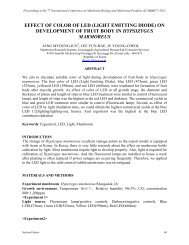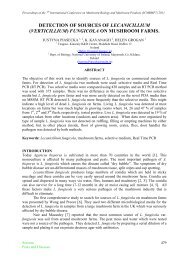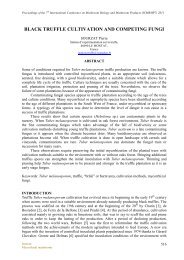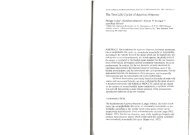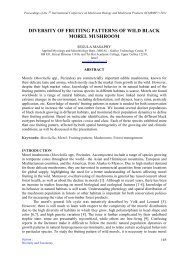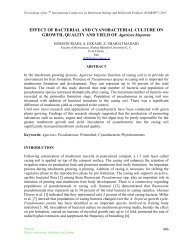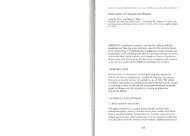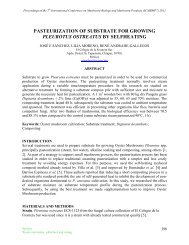Strain improvement of edible fungi with Pleurotus eryngii ...
Strain improvement of edible fungi with Pleurotus eryngii ...
Strain improvement of edible fungi with Pleurotus eryngii ...
Create successful ePaper yourself
Turn your PDF publications into a flip-book with our unique Google optimized e-Paper software.
Proceedings <strong>of</strong> the 7 th International Conference on Mushroom Biology and Mushroom Products (ICMBMP7) 2011<br />
PeC12 / P401 PeC35 / P. djamor PeC38 / ASP14<br />
PeC12 / P. djamor PeC35 / HK3539 PeC44 / P. djamor<br />
PeC20 / P. djamor PeC38 / P. djamor PeC44 / P401<br />
hybrids <strong>with</strong> similar mycelium growth than parental strains<br />
PeC11 /CP50 PeC35 /P401<br />
PeC35/ <strong>Pleurotus</strong> sp. PB PeC44 / CP253<br />
hybrids <strong>with</strong> slower mycelium growth than parental strains<br />
PeC12 / CP253 PeC20 / ASP14 PeC20 / IE201<br />
Biological efficiencies <strong>of</strong> the 19 hybrids produced by di-mon matings are shown in Table<br />
4. <strong>Strain</strong> PeC11/CP50 showed up as the highest producing hybrid <strong>with</strong> an amazing 323%<br />
biological efficiency, however, 3 other hybrids produced also very high yields, i.e. PeC9/CP50<br />
(271%), PeC12/P401 (207%) and PeC35/<strong>Pleurotus</strong> sp. PB (177%), in all cases, BE were<br />
significantly higher than BE <strong>of</strong> the parental P. <strong>eryngii</strong> dikaryon (151%). Remarkably, 12 more<br />
hybrids produced biological efficiencies higher than 100%; among them, 3 hybrids derived from<br />
P. djamor dikaryon <strong>with</strong> neohaplonts PeC12, PeC20 and PeC35 had significant higher biological<br />
efficiencies than the parental P. djamor dikaryon.<br />
Parental <strong>Strain</strong>s<br />
P. <strong>eryngii</strong> CP50 P401 <strong>Pleurotus</strong> sp. PB<br />
Hybrid <strong>Strain</strong>s<br />
PeC11/ CP50 PeC9/CP50 PeC12/P401 PeC35/ <strong>Pleurotus</strong> sp. PB<br />
Fruit bodies: small,<br />
medium and large. Pileus:<br />
light brown, <strong>with</strong> regular<br />
edges. Stipe: white,<br />
medium, thin, trumpet<br />
shaped<br />
Fruit bodies: medium<br />
and large. Pileus: beige<br />
<strong>with</strong> regular edges. Stipe:<br />
white, medium, thin,<br />
trumpet shaped<br />
Fruit bodies: large.<br />
Pileus: light brown<br />
<strong>with</strong> undulated edges.<br />
Stipe: white, medium,<br />
long and thin<br />
Fruit bodies: medium<br />
and large. Pileus: light<br />
brown <strong>with</strong> regular<br />
edges. Stipe: white,<br />
medium, long and thin to<br />
thick, trumpet shaped<br />
Figure 3: Parental strains and highest producing hybrids from di-mon matings <strong>with</strong> <strong>Pleurotus</strong><br />
morphologies<br />
Results from Table 4 also allow the identification <strong>of</strong> PeC35 as a neohaplont generating<br />
highly producing dikaryons when mated <strong>with</strong> different dikaryotic partners. These results also<br />
establish that most hybrids are higher yielding than the respective parental dikaryotic strains<br />
Section:<br />
Genomics, Genetics and Breeding<br />
67



